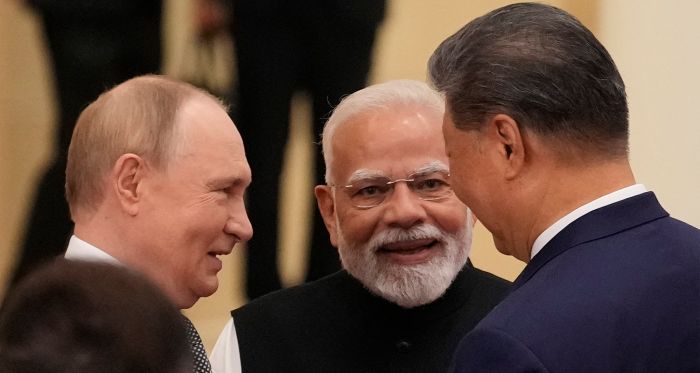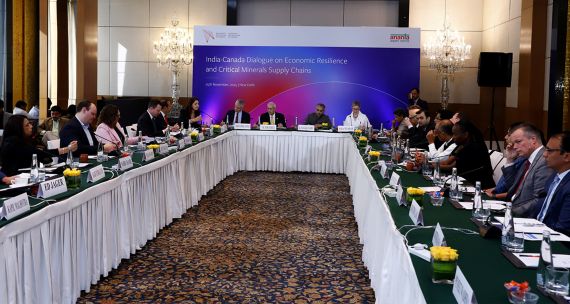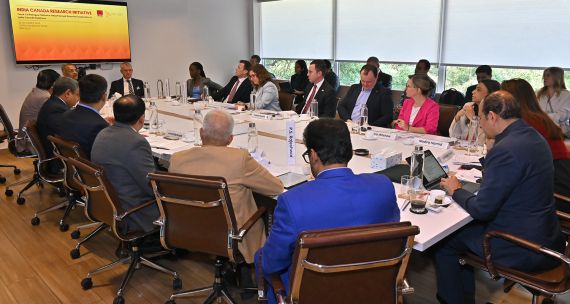Over the past two decades, India-U.S. relations have made steady strides, buoyed by bipartisan support in both countries and thriving in areas such as trade, technology, and strategic convergence in the Indo-Pacific. Yet the bilateral partnership has suffered an unprecedented setback in recent months. Beginning August 27, Indian exports to the U.S. face a steep 50 per cent tariff, including a 25 per cent penalty linked to India’s oil purchases from Russia. U.S. President Donald Trump adviser Peter Navarro has claimed India’s “oil lobby” is fuelling Moscow’s war in Ukraine. New Delhi counters that China is the largest buyer of Russian oil and notes that Western actors, including the E.U., still import Russian natural gas — yet neither faces penalties.
These shifts in relations between the U.S. and India have triggered an upheaval in the geopolitical landscape and prompted India to reassess its foreign policy toward major powers such as China and Russia. Washington’s cold shoulder has seemingly pushed New Delhi closer to both. Yet a deeper look at the evolving dynamics of India’s great-power relations reveals a more nuanced picture.
While India would prefer a resolution of its border conflict with China, there are no signs that the broader strategic and regional rivalry between the two Asian giants is receding. New Delhi remains committed to its foreign policy principle of ‘strategic autonomy’ — maximizing flexibility by avoiding formal alliances — and is therefore seeking a wider set of partnerships, including with Western actors, to bolster its defence, technology, and strategic interests. For Canada and India, the current moment presents significant opportunities to deepen co-operation across strategic sectors such as technology, trade, clean energy, and critical minerals, but much will depend on sustained high-level engagement.
A rupture in the India-U.S. strategic partnership
Although India initially appeared to be a frontrunner in securing a trade deal with Washington after the announcement of President Trump’s “reciprocal tariffs” in April 2025, negotiations have hit a dead end. A U.S. trade delegation, scheduled to visit India in August, was reportedly cancelled with no schedule for further talks finalized. India’s traditionally protectionist stance on agriculture and dairy is a sticking point in trade discussions; Indian Prime Minister Narendra Modi has remarked that he will not compromise on the interests of Indian farmers.
Moreover, while the U.S. was India’s largest trading partner in 2024, with bilateral trade in goods and services totalling US$212.3 billion, the Trump administration is displeased with its trade deficit, blaming India’s high tariff wall and referring to the country as a “tariff king.” In 2024, U.S. goods exports to India were worth US$41.5 billion, while goods imports from India were more than double that, at US$87.3 billion.
With the U.S. tariffs on Indian goods now taking effect, it may shave off about 0.5 per cent of India’s annual GDP growth if the tariffs last for over a year, pushing India’s growth below six per cent from a forecast of 6.5 per cent. Although the U.S. is the largest destination of Indian exports, the overall economic impact may be modest because key exports — such as pharmaceuticals and electronics (including mobile phones) — are exempted. However, sectors such as textiles and apparel, automobile parts, leather products, and gems and jewellery will bear the brunt, with small and medium enterprises expected to be hit the hardest. A bigger concern is that competitors in the neighbourhood are facing a much lower tariff: India’s arch-rival Pakistan at 19 per cent and Bangladesh at 20 per cent.
Observers in India are closely watching the growing proximity between Washington and Islamabad, as the two recently signed trade and energy agreements, including the joint development of Pakistan’s oil reserves. The Trump administration’s overtures to Pakistan have raised concern in New Delhi, which shares Washington’s goal of countering an increasingly assertive China. With China as Pakistan’s strongest ally — through defence, economic, and infrastructure ties — Washington’s latest moves have caught many in India off guard.
Moreover, the reception of Pakistani military chief, Field Marshal Asim Munir, at the White House — shortly after a violent military confrontation between India and Pakistan in May — and Trump’s repeated claim that he played a vital role in brokering the Indo-Pakistan ceasefire, have not been well received in India. Experts say Trump is miffed that New Delhi has refused to credit him for brokering the ceasefire, unlike Islamabad, which readily has.
While fissures in India-U.S. ties are undeniable, much will depend on the Trump administration’s next steps. In India, trust has been eroded, but there are no indications yet that New Delhi is prepared to abandon the relationship.
The limits of an India-China reset
With Indian Prime Minister Narendra Modi attending the Shanghai Cooperation Organization summit in Tianjin from August 31 to September 1, Modi’s first visit to China in seven years, much attention has focused on whether tensions with the U.S. are nudging India closer to China and Russia. Chinese Foreign Minister Wang Yi’s visit to India in August — underscored by an announcement to resume direct flights, reports of the lifting of Chinese export controls on rare earth magnets bound for India, and renewed efforts to resolve the two countries’ disputed border — has also signalled a warming of bilateral relations. This thaw marks a notable shift since India-China ties plunged to a historic low in 2020 following deadly border clashes that killed at least 20 Indian soldiers.
In India, calls are growing to diversify trade away from the U.S. and expand exports to China, Russia, South America, and Southeast Asia. India currently runs a trade deficit of roughly US$100 billion with China, a longstanding vulnerability it has sought to address. Meanwhile, with U.S. tariffs disrupting the global trading order, China has launched a charm offensive across South and Southeast Asia. Casting Washington as a “bully,” Chinese Ambassador to India Xu Feihong declared that Beijing “firmly opposes” the U.S. tariffs on India and called for deeper co-operation between the two Asian powers.
India-China relations had already shown signs of recovery since October 2024, when both sides agreed to resume co-ordinated patrols along their disputed Himalayan frontier. The initiation of a process for troop disengagement further fuelled speculation of a broader rapprochement, underscored by the bilateral meeting between Modi and Chinese President Xi Jinping at the 2024 BRICS Summit in Kazan — their first such meeting in five years.
While recent developments suggest that a Sino-Indian reset may be underway, underlying tensions, mutual suspicion, and regional rivalry between the two Asian powers persist. New Delhi was deeply unsettled by intelligence-sharing between Beijing and Islamabad during the India-Pakistan military confrontation in May, as well as Pakistan’s deployment of Chinese-made fighter jets, missiles, and other weaponry against India.
Other irritants in the bilateral relationship include a massive Chinese dam project in Tibet, which New Delhi fears could reduce water flows on major rivers by as much as 85 per cent during the dry season — raising the risk of an impending “water war.” And although both countries share an interest in defusing border tensions, their 3,488-kilometre disputed border, known as the Line of Actual Control (LAC), continues to fuel mistrust. This is exacerbated by fears of Beijing’s "salami-slicing" tactics, which allegedly involve incremental territorial gains at the LAC, including apprehensions in India that Chinese troops breached the Line during the 2020 clashes and occupied territory on the Indian side.
Since 2020, Chinese fortifications near the border — including the construction of villages, infrastructure, and enhanced logistical capabilities — have heightened perceived threats in New Delhi. In response, India has accelerated its own border infrastructure projects, such as the Sela Tunnel, which ensures year-round access to its northeastern frontiers, while strengthening road networks to enable rapid troop deployment. Both countries continue to prioritize infrastructure development along the LAC, underscoring persistent military competition.
At the same time, sections of Indian business and industry remain eager to deepen economic engagement with China and attract Chinese investment. Yet, India’s dependence on Chinese components for its manufacturing sector poses clear risks. Beijing’s export restrictions on rare earth elements and magnets — imposed earlier in 2025 and only recently lifted — exposed vulnerabilities in India’s supply chains, particularly in the automobile and electronics sectors. Moreover, while New Delhi seeks to diversify trade away from the U.S., the Chinese market is unlikely to serve as a substitute given its non-tariff barriers, such as quotas and bans on certain goods, and manufacturing overcapacity. In fact, Indian exports to China have declined by roughly 15 per cent over the past year; meanwhile, New Delhi remains wary of “dumping” of goods by China.
Another major flashpoint lies in the intensifying strategic rivalry over influence in the Indian Ocean region and neighbouring countries such as Bangladesh, the Maldives, Nepal, and Sri Lanka. India, which regards the Indian Ocean as its traditional sphere of influence, feels increasingly encircled by China’s infrastructure and port projects under Beijing’s Belt and Road Initiative. As a result, the broader Sino-Indian rivalry is unlikely to dissipate despite recent gestures towards a tactical reset.
Why a China-India-Russia axis is unlikely
Images of Russian President Vladimir Putin, Chinese President Xi Jinping, and Indian Prime Minister Narendra Modi at this summer’s Shanghai Cooperation Organization summit have fuelled speculation about the emergence of a new ‘troika’ that could present a united front in challenging U.S. power. Such concerns were further heightened by visits to Russia in August by Indian Foreign Minister S. Jaishankar and National Security Adviser Ajit Doval. India has also doubled down on its purchases of Russian oil, despite being hit with punitive tariffs by the Trump administration.
Nevertheless, it may be premature to conclude that a new China-India-Russia axis is taking shape, even amid rapidly shifting great-power dynamics. The war in Ukraine has deepened Moscow’s dependence on Beijing, and Trump’s tariffs have alienated New Delhi, which has historically enjoyed close ties with Russia. Yet fundamental differences remain between New Delhi and Beijing. The two Asian powers remain locked in a longstanding strategic rivalry rooted in historical mistrust and an unresolved border. India is also cautious of Russia’s growing closeness to China.
India-Russia relations remain underpinned by decades of co-operation, with roughly 40 per cent of India’s oil imports coming from Russia and around 60 per cent of its military equipment of Russian origin. However, New Delhi has, in recent years, sought to diversify its defence partnerships, increasingly turning toward France, Israel, and the U.S. Despite current tensions with Washington, India continues to cultivate stable partnerships with Australia, the E.U., Japan, and the U.K. in areas ranging from trade and technology to defence and critical minerals.
In fact, recent strains in India-U.S. relations have reinforced New Delhi’s commitment to its longstanding principle of strategic autonomy. Rather than embracing a China-India-Russia troika, India is more likely to continue diversifying its relationships and strengthening ties with a wide range of geopolitical actors.
Renewing Canada-India ties amid global turbulence
Against the backdrop of a shifting global order, Canada-India relations appear to be on the path to recovery after an 18-month period of heightened diplomatic strain that brought bilateral diplomatic ties to a near standstill. Building on a successful meeting between the two countries’ prime ministers on the sidelines of the G7 Leaders’ Summit in Kananaskis, Alberta, in June, both sides have reinstated high commissioners, established law-enforcement co-operation to address mutual security concerns, and underscored the importance of deepening partnerships in key strategic sectors such as emerging technologies, critical minerals, and resilient supply chains. Both countries, hit by steep U.S. tariffs, have so far been unable to secure relief from the Trump administration. As a result, trade diversification and economic resilience remain top priorities for both governments.
Announcing the appointment of a new envoy to India, Canada’s Foreign Minister Anita Anand described the move as crucial for “strengthening the bilateral relationship to support Canada’s economy.” Although negotiations on a free trade agreement were paused in September 2023, Prime Minister Mark Carney has pointed to India’s expanding economy and its vital role in global supply chains as compelling reasons to reset relations with New Delhi. While the immediate resumption of talks on a trade agreement appears unlikely, both countries have signalled renewed interest in a process of re-engagement, including closer co-operation on economic and trade issues — especially in light of the ongoing geopolitical and geo-economic upheaval.
Still, the road to full re-engagement will not be without challenges. To realize the full potential of collaboration across strategic sectors such as technology, trade, clean energy and critical minerals, both sides must address national security concerns, build mutual trust, and establish durable mechanisms for managing shocks in the relationship. Given shifting global and regional dynamics, Canada and India also need to re-evaluate and recalibrate their foreign and economic policies, including their respective Indo-Pacific strategies, particularly in light of their recently strained ties with the U.S. Even so, shared interests in trade, secure supply chains, and a free and open Indo-Pacific remain critical to both.
Conclusion: Strategic autonomy and diversification will endure
The recent downturn in the India-U.S. strategic partnership — steadily cultivated over the past two decades — underscores the rapidly shifting dynamics of the global order. Despite current tensions, the broader strategic convergence between the two powers, and their shared interests in technology, defence, and Indo-Pacific security, remain intact. Repairing the partnership remains possible, but it will require effort on both sides.
This turbulence has also prompted speculation about potential great-power realignments involving India, Russia and China. While it may be premature to label these shifts as a realignment, one certainty is clear: recent developments have strengthened India’s resolve to continue pursuing its foreign policy principle of strategic autonomy and its determination to diversify partnerships. In this context, the possibility of closer co-operation with Canada also comes into sharper focus.






